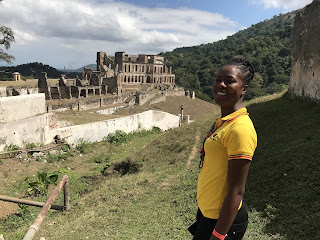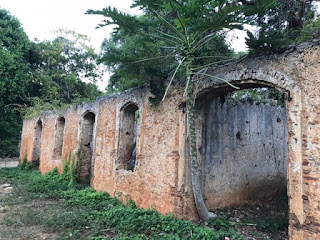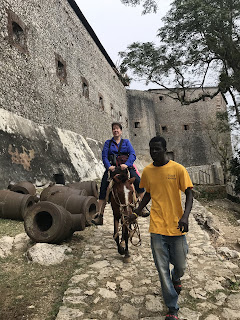Empowering people in Haiti to improve the environment --- Central Haiti ecotours! --- Northern Haiti ecotours!
Sunday, May 3, 2020
Sunday, March 8, 2020
How to make a Haitian meal
 My friend Lydie showed me how to make beans and rice, onion sauce, legume (vegetables), and bannann peze (fried plantains).
My friend Lydie showed me how to make beans and rice, onion sauce, legume (vegetables), and bannann peze (fried plantains).
Start beans in lots of water, with salt (I missed the bean preparation).
Clean rice (pick out rocks, blow out chaff) and rinse twice.
Put rice in cooking beans, turn up gas high to boil, when water evaporates stir and put on lid. Turn down heat and cook about 10 minutes, stir, turn down heat even more.
Meanwhile cook veggies in oil: lettuce leaves cut up, chayote cut in half and peeled (remove heart) peeled carrot chunks. Stir and cook about 5 minutes then add chopped onion, pepper, tomato, garlic, and some magi. Cover and cook. Add a little water later and stir.
While everything is cooking, peel and cut up plantains. Wash the pieces. Heat a lot of oil in frying pan, stand back and add plantain. Fry about 5 minutes until yellower then turn them and cook more. Turn some more and it gets yellower.
For onion sauce cut up tomato into a sauce pan then add some oil and cook. Add a tablespoon of butter or margarine, cook more, then add 2 cups of water and ‘a little’ (a spoonful) of rock salt. When sauce is almost done, add sliced onion.
Remove the plantains, fry cooked meat in the oil, then remove.
Meanwhile crush each plantain between two plates. Dip each piece in a bowl of salt water, then fry in the meat oil. Turn once and fry around 5 minutes.
Friday, February 21, 2020
Citadelle 2020 Part 2 - The views
 Here are
some photos from the excursion to the Citadelle! It was overcast with low
clouds at the Citadelle, but full sun at the Palace.
Here are
some photos from the excursion to the Citadelle! It was overcast with low
clouds at the Citadelle, but full sun at the Palace. |
| Palace San Souci, from the road above. |
Tuesday, February 18, 2020
Citadelle 2020 part 1 - the road there and payment
 |
| Too many people trying to help! |
On a Monday
in February 2020 I took a visitor to the Citadelle! Rather my Haitian friend
took us and helped us navigate not only the road there but payment. Let your
Haitian friend take charge of all payments! (I didn’t and overpaid the horse
guides). Here is what we did. Hope it saves others from confusion! And you need
a really good truck with good motor and clutch to go up and down the mountain.
The
drive: 7 hour round trip! Left UCNH in Haute-Limbe at 6:45a. Go
earlier if you want to go birding. From Rt 1 we turned south onto the nice road
through Akul, then went south through Bois Rouge and popped out on the main
paved road that goes south to Milot. 8am arrive at the tourist payment
building at Palace San Souci, after we picked up a guide who was standing
on the street outside a nice gate/walled area. He had a badge and rode with us
in the truck bed. FYI he spoke Creole, French, and Spanish, but very little
English. My friend ended up translating. 9 am arrive at Citadelle parking
lot. 9:40a arrive at Citadelle whether you rode a horse or walked. 10:30a
left Citadelle. Noon back in truck at tourism building and left. We
returned on the road that runs along the south edge of the Cap airport. 1pm
arrive at Rt1 out of Cap. 2pm pull into UCNH.
At the
tourism building: They give you the list of prices (see photo below). We
only paid the entrance fee of 2300 gds for 2 foreigners and 3
Haitians. They couldn’t make change! The guide exchanged smaller bills with
us. Supposedly you can pay for all services there and not be charged later in
the main parking lot right below the Citadelle. At the tourism booth they
charge $15US (1500 gds) for a horse (then you tip your 2 horse guides). But
it’s cheaper to hire a horse on your own at the parking lot above. Which I
didn’t know, and paid 2000 gds and told the 2 guides to split the extra 500. Didn’t
know my friend had negotiated 1000 gds for a horse. At the end we gave the
guide 3000gd. And I paid for gas and use of my friend’s truck.
Souvenir
sellers: Be prepared for all the art and souvenir sellers in both parking
lots. I put a predetermined amount of cash in my pocket, small US bills. And
spent only that. They will ask $10US for a wood bowl. Then when you get in your
car to leave, they will say you can have 2 bowls for $5US! I had to roll up the
window and close the door, they are very assertive.
The horse
ride up: Choose only horses that have the hibiscus logo branded into the
horse. My vet friend trains the horse owners to care for the horses and gives
the brand to those who passed. I took a horse (Tako) so I wouldn’t be so tired
at the top, but it’s not a bad walk. Steep but smooth stones. The horse is too
bumpy for bird watching and they didn’t stop much.
 |
| The building where you pay the entrance fee for Palace San Souci and Citadelle. |

 |
| The hibiscus brand on horses managed by people who received training in horse care. |
Tuesday, February 11, 2020
Belly Beach bird hike
 |
| Fort Belly |
The real reason
I wanted to stay overnight at Belly Beach was to go birding. Get up early and head up the
stairs to a rocky road that sits above the bay. There are unique rock
formations, a nice view of the bay, and a little fort my guide called Labadee
Fort, and google maps labeled Fort Belly. There are typical birds – kingbirds,
Antillean mangos, warblers. And also white-crowned pigeons which I have only
seen once in Haiti, in the south.
 |
| Lichen |
 |
| Walk up the stairs from the hotel |
 |
| Rocky road |
 |
| Spanish moss |
 |
| Cruise ship at Labadee |
Belly Beach near Labadee Haiti
 Belly Beach is a small beach and hotel on the bay between the Royal Caribbean Cruise resort of Labadee and the Haitian village of Labadee. It has fewer foreigners than Cormier Plage, and better swimming in the calm bay and blue water (somewhat cloudy from all the boat activity). It's a nice place to spend the evening. We arrived around 5p on a Sunday, loud music was playing, people were enjoying the beach, but it wasn't too rowdy. They turned off music around 7p and most of the day-use people had left by then, so we enjoyed our meal in peace.
Belly Beach is a small beach and hotel on the bay between the Royal Caribbean Cruise resort of Labadee and the Haitian village of Labadee. It has fewer foreigners than Cormier Plage, and better swimming in the calm bay and blue water (somewhat cloudy from all the boat activity). It's a nice place to spend the evening. We arrived around 5p on a Sunday, loud music was playing, people were enjoying the beach, but it wasn't too rowdy. They turned off music around 7p and most of the day-use people had left by then, so we enjoyed our meal in peace.  We didn't make reservations, and seemed to be the only people staying overnight. There were around 10 rooms, $60/night. Each has a mini-fridge, TV, air conditioner, and indoor plumbing. There are no windows so we couldn't enjoy the view or sounds of the waves whiles we slept. Electricity was on until around 11pm. The main water pipe to the compound had broken, so there wasn't water that evening to the rooms (because they didn't know we were coming they hadn't filled the reservoir), but we could shower in the day-use facilities. The rooms had water by morning. The stay came with a hearty breakfast of eggs, bread, coffee. The manager speaks English and was pleasant, along with the woman who manages the rooms. Dinner and drinks for 5 was $30. They take only cash! Check out is 11am.
We didn't make reservations, and seemed to be the only people staying overnight. There were around 10 rooms, $60/night. Each has a mini-fridge, TV, air conditioner, and indoor plumbing. There are no windows so we couldn't enjoy the view or sounds of the waves whiles we slept. Electricity was on until around 11pm. The main water pipe to the compound had broken, so there wasn't water that evening to the rooms (because they didn't know we were coming they hadn't filled the reservoir), but we could shower in the day-use facilities. The rooms had water by morning. The stay came with a hearty breakfast of eggs, bread, coffee. The manager speaks English and was pleasant, along with the woman who manages the rooms. Dinner and drinks for 5 was $30. They take only cash! Check out is 11am. The morning was the best part for me - I came there to bird and explore. Go up the stairs and to the left to follow the road seen on google maps. There is a small fort, and lots of birds (see next blog). Go up the stairs to the right to get to the next beach over where people sell souvenirs to the cruise ship tourists. Tell them you are not from the cruise ship! The sellers are pleasant and not too pushy, but did try to charge 3x as much as they finally seemed happy taking.
The morning was the best part for me - I came there to bird and explore. Go up the stairs and to the left to follow the road seen on google maps. There is a small fort, and lots of birds (see next blog). Go up the stairs to the right to get to the next beach over where people sell souvenirs to the cruise ship tourists. Tell them you are not from the cruise ship! The sellers are pleasant and not too pushy, but did try to charge 3x as much as they finally seemed happy taking.Next time I would like to get there before noon, leave my belongings (and give time for water to the rooms), then take a boat to Labadee village to eat lunch and explore.
How to get there - Though google shows a road that looks like it goes directly to Belly Beach - it's really just a very rocky path that I don't think any truck could manage, and it stops at stairs that lead down to the hotel. On google maps Belly Beach is called Dhaloo, while a place within the resort compound is labeled as Belly Beach. To get to Belly, follow the road past the resort and park near the water taxis. Royal Caribbean had a ship in port the day I went, and when we arrived at 4 pm the area was very busy with employees who work in the resort. Hire a water taxi to take you to Belly. Pay 100 gd for the trip there, and arrange for pick up the next day for 1000 gd.
 |
| water taxi |
 |
| Dinner |
 |
| Breakfast |
Sunday, January 5, 2020
Haiti Hiatus 2019
My usual
return to Haiti to teach during the 2019 fall semester was canceled due to the
protests that disrupted life not only in Port au Prince, but across the
country. Even rural areas were affected as supplies couldn’t leave PauP and gas
prices increased. Schools and universities ended up closing since students and teachers
could not travel the roads Author Amy Wilentz wrote a synopsis of what led to
the escalated protests and lock-up of the country: https://www.thenation.com/article/haiti-protests-petrocaribe/
Miami Herald also gives regular updates. At UCNH, classes resumed late
Nov./Dec. as intensive courses, and exams will take place this month (January
2020). Si Bondye vle things will stay calm and schools will resume this year.
Here's a couple paragraphs from the Wilentz article (24 Oct. 2019) in The Nation:
Gas shortages related to the government’s inability to pay for shipments have plagued the country since the end of PetroCaribe, and continue today. When there is no gas, hospitals can’t provide medical care, bodies can’t get transported for burial and morgues begin to stink, transit stops, markets languish, schools shut, all industry collapses, and the gas-fueled generators that small businesses and better-off homeowners use for electricity during the long daily power outages shut down.
Meanwhile, in less than a year, the gourde, Haiti’s national currency, has lost a third of its value, with inflation up 20 percent. Thanks to runaway inflation, the little Haitians do manage to scrape together is now worth half of what it was worth four years ago. The price of chicken has doubled over the past few years, a liter of milk can cost as much as half the daily $2.50 minimum wage—which most people don’t even make because they operate in the “parallel” economy where the minimum wage is often $0. The annual per capita income is about $350 in the countryside and $410 in the city, and the price of a cup of rice, the national staple, has been rising by about 10 percent every 10 months. Meanwhile, families have already paid their school fees this year, but because of the protests and the lack of gas, they haven’t been able to send their kids to school. In a world without fuel and without jobs, there’s nothing to do. Except protest. Each week, the protests grow. They’re organized, too. One important group organizing marches in Haiti and in the Haitian diaspora is, fittingly, called Nou pap domi, or We Will Not Sleep.Gas shortages related to the government’s inability to pay for shipments have plagued the country since the end of PetroCaribe, and continue today. When there is no gas, hospitals can’t provide medical care, bodies can’t get transported for burial and morgues begin to stink, transit stops, markets languish, schools shut, all industry collapses, and the gas-fueled generators that small businesses and better-off homeowners use for electricity during the long daily power outages shut down.
Subscribe to:
Posts (Atom)










